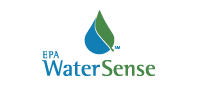- WaterSense
- Questions & Answers About the WaterSense Program
Questions & Answers About the WaterSense Program

Why does the United States need a water efficiency program?
Water is a finite resource. Between 70 and 75 percent of the Earth's surface is covered with water, but only 1 percent of that is available for human use. While both world population and the demand for freshwater resources are increasing, supply remains constant. Water efficiency helps preserve our water supply for future generations.
Is water supply an issue everywhere in the United States?
There are many markets in the United States that already face water shortages, and the number of markets facing this issue is projected to grow in the future. A Government Accountability Office survey of water managers across the country showed that at least 36 states were anticipating local, regional, or statewide water shortages by 2013, even under non-drought conditions. Water efficiency is a much more cost-effective tool to help local markets manage water supply issues than developing new sources.
How can water efficiency help local communities?
Water supply infrastructure is a major cost for most local markets across the United States. In 2002, a U.S. Environmental Protection Agency (EPA) report identified a $224 billion gap in planned infrastructure investment as compared to needs. Water efficiency is one key way that local communities can help manage their infrastructure needs.
Which areas of the country have the largest water supply challenges?
Water use varies greatly depending on geographic location and season, largely as a result of differences in climate. For instance, water use needs tend to be higher in the West and Southwest than in the East or Midwest. However, water and wastewater infrastructure systems across the country are being challenged by population growth and aging components. Water efficiency can lessen the stress on these systems and extend their useful life. Further complicating the issue of water supply and availability is the fact that population growth is greatest in states that have more limited water resources.
Why did EPA create WaterSense?
EPA realized that managing water supplies was becoming an increasingly important issue to local markets around the country. Through this national program, local water utilities, product manufacturers, and retailers will work with EPA to encourage water-efficient products and practices among consumer and commercial audiences.
What is the goal of WaterSense?
The main goal of the program is to decrease indoor and outdoor non-agricultural water use through more efficient products, services, and practices and create a program that helps customers differentiate between products in the marketplace, while ensuring product performance and encouraging innovation in manufacturing.
How will EPA ensure that these products work as well as conventional models?
Performance criteria are a critical component to each WaterSense product specification developed. Products are required to be independently tested and certified to perform to the criteria established for each WaterSense labeled product.
What products are included in the WaterSense program?
Irrigation products and professionals are among the first categories in the program, along with high-efficiency toilets and faucet products. EPA plans to research several options to expand product areas in the future, including additional indoor and outdoor home products, as well as commercial products.
How are water-efficient products labeled/recognized?
The WaterSense label differentiates products that meet EPA's criteria for efficiency and performance. This label appears on product packaging, on in-store displays, and in manufacturer literature and Web sites. Furthermore, shoppers can visit www.epa.gov/watersense to see a registry of labeled products.
How are specifications for products being determined?
For each product under consideration, EPA conducts extensive research to analyze potential specifications. Draft efficiency and performance criteria are developed for the specification as an open process, and EPA solicits input from stakeholders to ensure that the most appropriate criteria are selected for each product category before finalizing the specification.
How does EPA ensure that products meet the criteria?
Products will be independently certified to meet or exceed the criteria before they are allowed to bear the label or be listed on the WaterSense Web site. EPA requires third-party certification by a licensed certifying body to ensure conformance with the specification.
What other benefits do WaterSense labeled products provide?
It takes a lot of energy to pump, treat, and supply water to your home. Using water efficiently not only saves energy, but reduces the greenhouse gas emissions associated with electricity generation. If just 1 percent of American homes remodeled with water-efficient fixtures, we could save electricity and reduce emissions equal to removing 15,000 cars from the road for a year.
How is EPA coordinating with local water utilities?
Local water utilities have been very supportive in the development of the program. Many utilities already have efforts in place to increase the water efficiency of residential and commercial irrigation systems. Utilities are encouraged to partner with WaterSense and use the program as part of their local water efficiency and conservation efforts.
What more can I do to save water for future generations?
EPA conducts a number of activities to encourage consumers and organizations to use less water. Information on how to use water efficiently is posted on our Web site, www.epa.gov/watersense, and available on our fact sheets and other publications.










